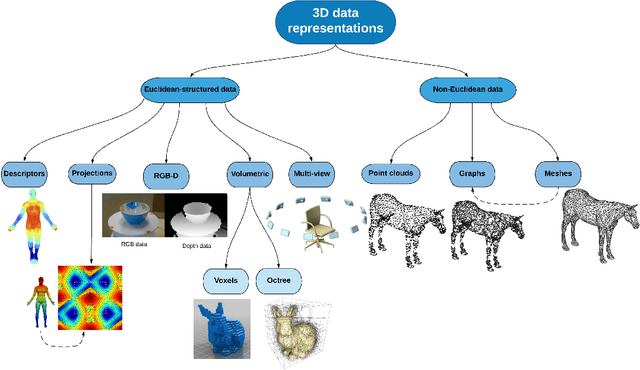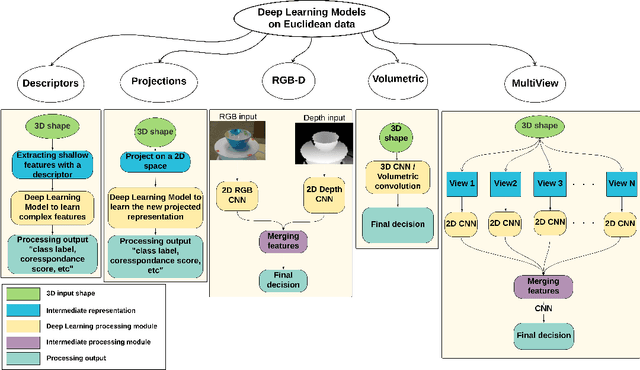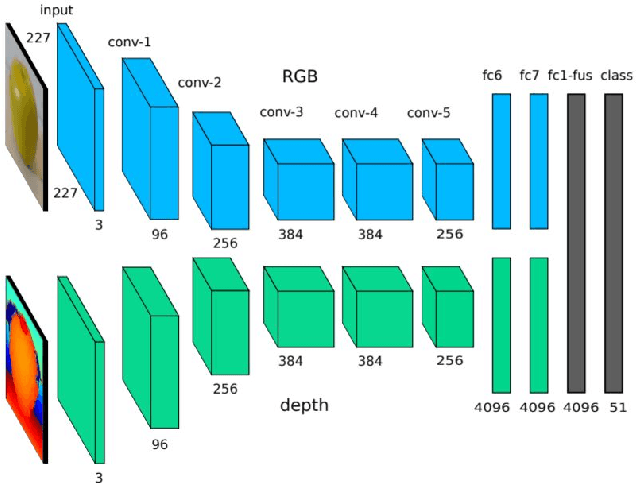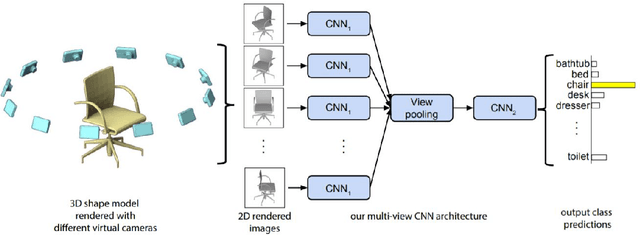Abd El Rahman Shabayek
Removing Geometric Bias in One-Class Anomaly Detection with Adaptive Feature Perturbation
Mar 07, 2025



Abstract:One-class anomaly detection aims to detect objects that do not belong to a predefined normal class. In practice training data lack those anomalous samples; hence state-of-the-art methods are trained to discriminate between normal and synthetically-generated pseudo-anomalous data. Most methods use data augmentation techniques on normal images to simulate anomalies. However the best-performing ones implicitly leverage a geometric bias present in the benchmarking datasets. This limits their usability in more general conditions. Others are relying on basic noising schemes that may be suboptimal in capturing the underlying structure of normal data. In addition most still favour the image domain to generate pseudo-anomalies training models end-to-end from only the normal class and overlooking richer representations of the information. To overcome these limitations we consider frozen yet rich feature spaces given by pretrained models and create pseudo-anomalous features with a novel adaptive linear feature perturbation technique. It adapts the noise distribution to each sample applies decaying linear perturbations to feature vectors and further guides the classification process using a contrastive learning objective. Experimental evaluation conducted on both standard and geometric bias-free datasets demonstrates the superiority of our approach with respect to comparable baselines. The codebase is accessible via our public repository.
Hybrid Attention for Robust RGB-T Pedestrian Detection in Real-World Conditions
Nov 06, 2024



Abstract:Multispectral pedestrian detection has gained significant attention in recent years, particularly in autonomous driving applications. To address the challenges posed by adversarial illumination conditions, the combination of thermal and visible images has demonstrated its advantages. However, existing fusion methods rely on the critical assumption that the RGB-Thermal (RGB-T) image pairs are fully overlapping. These assumptions often do not hold in real-world applications, where only partial overlap between images can occur due to sensors configuration. Moreover, sensor failure can cause loss of information in one modality. In this paper, we propose a novel module called the Hybrid Attention (HA) mechanism as our main contribution to mitigate performance degradation caused by partial overlap and sensor failure, i.e. when at least part of the scene is acquired by only one sensor. We propose an improved RGB-T fusion algorithm, robust against partial overlap and sensor failure encountered during inference in real-world applications. We also leverage a mobile-friendly backbone to cope with resource constraints in embedded systems. We conducted experiments by simulating various partial overlap and sensor failure scenarios to evaluate the performance of our proposed method. The results demonstrate that our approach outperforms state-of-the-art methods, showcasing its superiority in handling real-world challenges.
Multi-Objective Hardware Aware Neural Architecture Search using Hardware Cost Diversity
Apr 15, 2024Abstract:Hardware-aware Neural Architecture Search approaches (HW-NAS) automate the design of deep learning architectures, tailored specifically to a given target hardware platform. Yet, these techniques demand substantial computational resources, primarily due to the expensive process of assessing the performance of identified architectures. To alleviate this problem, a recent direction in the literature has employed representation similarity metric for efficiently evaluating architecture performance. Nonetheless, since it is inherently a single objective method, it requires multiple runs to identify the optimal architecture set satisfying the diverse hardware cost constraints, thereby increasing the search cost. Furthermore, simply converting the single objective into a multi-objective approach results in an under-explored architectural search space. In this study, we propose a Multi-Objective method to address the HW-NAS problem, called MO-HDNAS, to identify the trade-off set of architectures in a single run with low computational cost. This is achieved by optimizing three objectives: maximizing the representation similarity metric, minimizing hardware cost, and maximizing the hardware cost diversity. The third objective, i.e. hardware cost diversity, is used to facilitate a better exploration of the architecture search space. Experimental results demonstrate the effectiveness of our proposed method in efficiently addressing the HW-NAS problem across six edge devices for the image classification task.
Hardware Aware Evolutionary Neural Architecture Search using Representation Similarity Metric
Nov 07, 2023Abstract:Hardware-aware Neural Architecture Search (HW-NAS) is a technique used to automatically design the architecture of a neural network for a specific task and target hardware. However, evaluating the performance of candidate architectures is a key challenge in HW-NAS, as it requires significant computational resources. To address this challenge, we propose an efficient hardware-aware evolution-based NAS approach called HW-EvRSNAS. Our approach re-frames the neural architecture search problem as finding an architecture with performance similar to that of a reference model for a target hardware, while adhering to a cost constraint for that hardware. This is achieved through a representation similarity metric known as Representation Mutual Information (RMI) employed as a proxy performance evaluator. It measures the mutual information between the hidden layer representations of a reference model and those of sampled architectures using a single training batch. We also use a penalty term that penalizes the search process in proportion to how far an architecture's hardware cost is from the desired hardware cost threshold. This resulted in a significantly reduced search time compared to the literature that reached up to 8000x speedups resulting in lower CO2 emissions. The proposed approach is evaluated on two different search spaces while using lower computational resources. Furthermore, our approach is thoroughly examined on six different edge devices under various hardware cost constraints.
Impact of Disentanglement on Pruning Neural Networks
Jul 19, 2023Abstract:Deploying deep learning neural networks on edge devices, to accomplish task specific objectives in the real-world, requires a reduction in their memory footprint, power consumption, and latency. This can be realized via efficient model compression. Disentangled latent representations produced by variational autoencoder (VAE) networks are a promising approach for achieving model compression because they mainly retain task-specific information, discarding useless information for the task at hand. We make use of the Beta-VAE framework combined with a standard criterion for pruning to investigate the impact of forcing the network to learn disentangled representations on the pruning process for the task of classification. In particular, we perform experiments on MNIST and CIFAR10 datasets, examine disentanglement challenges, and propose a path forward for future works.
Deep Learning Advances on Different 3D Data Representations: A Survey
Aug 04, 2018



Abstract:3D data is a valuable asset in the field of computer vision as it provides rich information about the full geometry of sensed objects and scenes. With the recent availability of large 3D datasets and the increase in computational power, it is today possible to consider applying deep learning to learn specific tasks on 3D data such as segmentation, recognition and correspondence. Depending on the considered 3D data representation, different challenges may be foreseen in using existent deep learning architectures. In this paper, we provide a comprehensive overview of various 3D data representations highlighting the difference between Euclidean and non-Euclidean ones. We also discuss how deep learning methods are applied on each representation, analyzing the challenges to overcome.
Automatic Classification of Bright Retinal Lesions via Deep Network Features
Jul 28, 2017



Abstract:The diabetic retinopathy is timely diagonalized through color eye fundus images by experienced ophthalmologists, in order to recognize potential retinal features and identify early-blindness cases. In this paper, it is proposed to extract deep features from the last fully-connected layer of, four different, pre-trained convolutional neural networks. These features are then feeded into a non-linear classifier to discriminate three-class diabetic cases, i.e., normal, exudates, and drusen. Averaged across 1113 color retinal images collected from six publicly available annotated datasets, the deep features approach perform better than the classical bag-of-words approach. The proposed approaches have an average accuracy between 91.23% and 92.00% with more than 13% improvement over the traditional state of art methods.
 Add to Chrome
Add to Chrome Add to Firefox
Add to Firefox Add to Edge
Add to Edge